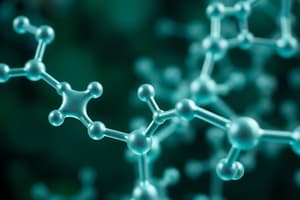Podcast
Questions and Answers
Glycine is an asymmetric center
Glycine is an asymmetric center
False (B)
D-amino acids are found in proteins
D-amino acids are found in proteins
False (B)
Histamine is an α-amino acid
Histamine is an α-amino acid
False (B)
NH2 group is always attached to the α-carbon atom in amino acids
NH2 group is always attached to the α-carbon atom in amino acids
Taurine is a constituent of vitamin B5
Taurine is a constituent of vitamin B5
Citrulline is a standard amino acid
Citrulline is a standard amino acid
Glycine is a branched chain amino acid.
Glycine is a branched chain amino acid.
Amino acids with amide groups include Aspartic acid and Glutamic acid.
Amino acids with amide groups include Aspartic acid and Glutamic acid.
Phenylalanine is a heterocyclic amino acid.
Phenylalanine is a heterocyclic amino acid.
Non-polar amino acids are generally found on the surface of proteins that interact with lipids.
Non-polar amino acids are generally found on the surface of proteins that interact with lipids.
Cysteine residues can form a peptide bond.
Cysteine residues can form a peptide bond.
Charged side chains include Asparagine and Glutamine.
Charged side chains include Asparagine and Glutamine.
All amino acids have a planar structure.
All amino acids have a planar structure.
There are 30 amino acids that occur in proteins.
There are 30 amino acids that occur in proteins.
The side chain (R-group) of an amino acid determines its metabolic fate.
The side chain (R-group) of an amino acid determines its metabolic fate.
Amino acids are linked to each other through ionic bonds.
Amino acids are linked to each other through ionic bonds.
The body can synthesize all amino acids.
The body can synthesize all amino acids.
Each amino acid has a unique one-letter symbol.
Each amino acid has a unique one-letter symbol.
Flashcards
Aliphatic Amino Acids
Aliphatic Amino Acids
Amino acids with a side chain containing a simple chain of carbon atoms, also known as alkyl groups.
Branched Chain Amino Acids
Branched Chain Amino Acids
Amino acids with a side chain containing a branched chain of carbon atoms.
Hydroxy-Amino Acids
Hydroxy-Amino Acids
Amino acids with a side chain containing a hydroxyl (-OH) group.
Sulfur-containing Amino Acids
Sulfur-containing Amino Acids
Signup and view all the flashcards
Amino Acids with Amide Group
Amino Acids with Amide Group
Signup and view all the flashcards
Acidic Amino Acids
Acidic Amino Acids
Signup and view all the flashcards
Basic Amino Acids
Basic Amino Acids
Signup and view all the flashcards
Aromatic Amino Acids
Aromatic Amino Acids
Signup and view all the flashcards
Heterocyclic Amino Acids
Heterocyclic Amino Acids
Signup and view all the flashcards
Non-Polar Amino Acids
Non-Polar Amino Acids
Signup and view all the flashcards
Polar Amino Acids
Polar Amino Acids
Signup and view all the flashcards
Disulfide Bond
Disulfide Bond
Signup and view all the flashcards
γ-Amino Butyric Acid (GABA)
γ-Amino Butyric Acid (GABA)
Signup and view all the flashcards
Beta-Alanine
Beta-Alanine
Signup and view all the flashcards
Dopamine
Dopamine
Signup and view all the flashcards
Thyroxine
Thyroxine
Signup and view all the flashcards
Histamine
Histamine
Signup and view all the flashcards
Non-Standard Amino Acids
Non-Standard Amino Acids
Signup and view all the flashcards
Study Notes
Classification of Amino Acids
- Aliphatic amino acids: Monoamino monocarboxylic acids (Simple amino acids: Glycine, Alanine), Branched chain amino acids (Valine, Leucine, Isoleucine), Hydroxy-amino acids (Serine, Threonine), Sulfur-containing amino acids (Cysteine, Methionine), Amino acids with amide group (Asparagine, Glutamine)
Acidic and Basic Amino Acids
- Monoamino dicarboxylic acids: Aspartic acid, Glutamic acid (acidic)
- Dibasic monocarboxylic acids: Lysine, Arginine (basic)
Aromatic and Heterocyclic Amino Acids
- Aromatic amino acids: Phenylalanine, Tyrosine
- Heterocyclic amino acids: Tryptophan, Histidine
Side Chain Character
- Non-polar side chains (hydrophobic): Ala, Val, Leu, Ile, Met, Phe, Try, Pro
- Polar side chains (hydrophilic): Ser, Thr, Tyr, Asn, Gln, Cys
- Charged side chains: Acidic (Glu, Asp), Basic (Lys, Arg, His)
Bonds and Interactions
- Non-polar amino acids participate in hydrophobic interactions
- Polar amino acids form hydrogen bonds
- Negatively charged acidic amino acids and positively charged basic amino acids form ionic bonds at physiological pH
- Two cysteine residues form a disulfide bond, producing cystine
Location of Polar and Non-Polar Amino Acids
- Non-polar amino acids are generally found in the interior of proteins that function in an aqueous environment
- Polar amino acids are generally found on the outside of proteins that function in an aqueous environment
Non-Standard Amino Acids
- γ-Amino butyric acid (GABA) derived from glutamic acid
- Beta alanine is a constituent of pantothenic acid (vitamin B5)
- Dopamine, Thyroxine (tyrosine derivative), Histamine (histidine derivative)
- Ornithine, Citrulline, Homocysteine are produced during the metabolism of amino acids
Importance of Amino Acids
- Formation of protein
- Formation of glucose and ketone bodies
- Enzyme activity: cysteine (-SH)
- Transport and storage form of ammonia: Gln
- As a buffer: histidine
- Detoxification: Gly, Cys
- Used as a drug: D-Penicillamine (D-dimethylglycine) for Wilson's disease
Studying That Suits You
Use AI to generate personalized quizzes and flashcards to suit your learning preferences.




